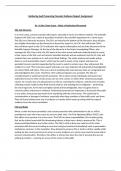Other
BTEC L3 NED Applied Science - Unit 23 - Learning Aim A
- Institution
- PEARSON (PEARSON)
This assignment attained a distinction first attempt, gives a very detailed explanation of different types of personnel and their roles, methods of searching, and ways to collect and preserve evidence, with explanation of chain of evidence
[Show more]



